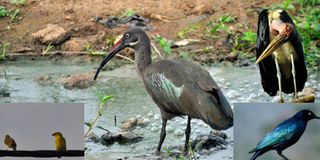Birding, excursion not far from home

Clockwise: The Hadada ibis in a swamp in Mbarara, a marabou stork on a leafless tree, Rupell’s long blue- tailed starling, and black-headed weavers perch as they take in the breeze. You do not have to look far away for bird species. , HOTOS BY EDGAR R. BATTE.
The beauty of birding is that you do not necessarily have to move miles. After breakfast at my hotel room in Mbarara town, I took a walk around the facility. Within minutes and metres, I got reason to stretch my camera lenses in different directions.
Of course, locals living in the swampy neighbourhood could not help but wonder as I took different positions to take good angles of the birds which were enjoying what is left of their natural habitat.
In the sky was the Marabou Stork, standing on a branch of a leafless tree, preening up in the early morning hours. Its friends were doing the same, pecking in their feathers.
Moving around
At a water channel full of putrid were two buddies, hadada or hadeda ibis, who were on a search mission for breakfast. They did not mind the stench from the wide water hole, all they cared about finding something to eat.
Walking around the channel and taking turns to dip their beaks into the smelly waters, they were glad to momentarily find something edible and taking time to feed off it. They did not mind celebrating as they did so, making noise in the relatively quiet neighbourhood.
But not everyone is a nuisance in this Mbarara vicinity. Somewhere on the electricity wires, the Angolan Swallow looked on, quietly, only takes flight to change location, for comfort or to feed on a variety of flying insects.
More bird species
Right within low-lying flowers, the equally colourful Black headed Weavers, whose yellow body rhymed with the coloured flowers within which they rested and fed. They would feed off flowers and then fly to the water channel to quench thirst or wash down the leafy meal.
Ruppell’s long-tailed starling was the most active of all these which stood out for its colour variety- a beautiful green on its features, a bluish, purplish body and distinctively yellow eyes.
Fellow birder, Achilles Byaruhanga, tells me it is a common bird around town where there still remnants of fruit trees.




